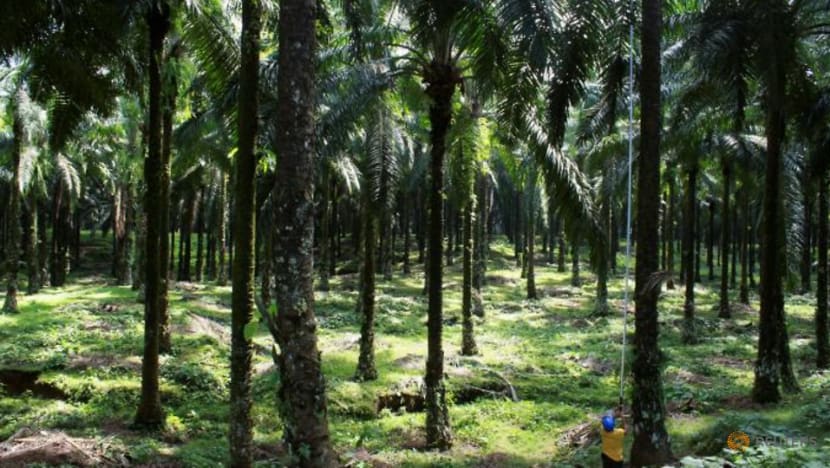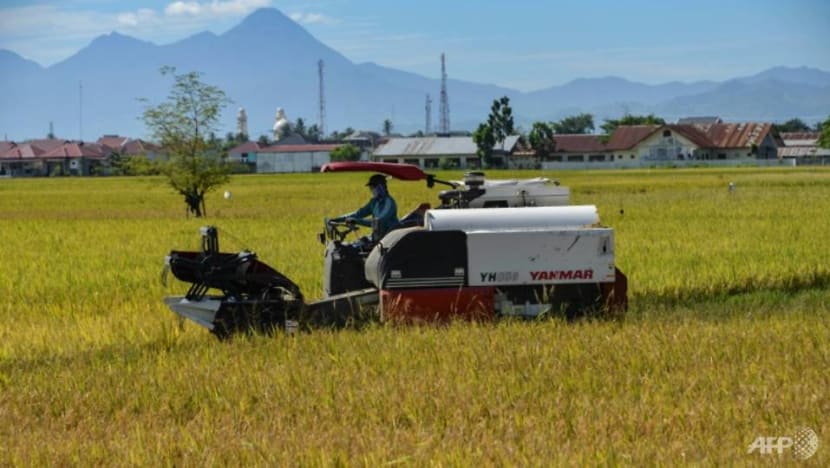commentary Commentary
Commentary: Why Indonesian farmers may become extinct in about 40 years
As farmers become older and their children become more educated, experienced hands that can till the land are becoming scarce, says Ronny Sasmita.

A farmer sprays pesticide onto a paddy field in Blang Bintang, Aceh province, Indonesia on Aug 7, 2020. (Photo: AFP/Chaideer Mahyuddin)
JAKARTA: It is a bold and somewhat depressing prediction: That by 2063, the Indonesian farmer will disappear as a profession.
This according to the National Development Planning Agency of Indonesia (Bappenas).
Their projection bears out the slow decline of workers in the agricultural sector.
Bappenas data shows that the proportion of Indonesian workers in the agricultural sector reached 65.8 per cent in 1976.
However, in 2019 it decreased significantly to only 28 per cent.
READ: Indonesia starts developing controversial food estate project
Part of this decline can be attributed to agricultural sector workers switching professions to other sectors, especially to services. In 1976, service sector workers accounted for 23.57 per cent and this increased to 48.91 per cent in 2019.
Likewise, the proportion of workers in the industrial sector increased to 22.45 per cent in 2019 from the previous 8.86 percent in 1976.
Aside from the shifting workforce, Bappenas also attributes the decline in the number of workers in the agricultural sector with the decreasing number of agricultural land.
In 2013, agricultural land reached 7.75 million hectares, but in 2019 it decreased to 7.45 million hectares. One of the driving factors is land use change due to rapid urbanisation.

Whereas in 2045 the population living in urban areas is estimated to increase to reach 67.1 per cent. Based on these trends, the farming profession is under heavy risk of disappearing, said Acting Director at Bappenas, Mia Amalia.
SHIFTING DEMOGRAPHICS
For years, farmers relied heavily on the weather for a good harvest. For them, a crop failure would be devastating – not only wiping out their incomes but also potentially putting them and their families in starvation.
With increased changes in climate, an unpredictable harvest cycle and the pest attacks have added to the problems farmers have faced.
READ: Commentary: Rising sea levels and sinking land are hitting big cities but the solution is far from simple
Another dilemma for farmers happens when their own children become educated, robbing them of successors. Children sent to the city to pursue a good education are very reluctant to return to the village and take on their parents' agricultural businesses.
Children who go to school are expected to become "someone" who will remove their families from poverty in the agricultural sector. Fewer young people pick farming.
Only 23 per cent of the country’s 14.2 million people under the age of 24 worked in agriculture, forestry or fishery according to data from the National Labour Force.
Those left to struggle in the agricultural sector are those who have little education and nothing else to do. And this can lead to a substandard quality of farming.
Oil palm smallholders, for example, tend to get a much lower selling price than palm oil from corporate-owned plantations who naturally have better yield because they have sophisticated plantation technology and a highly scheduled maintenance system.
Smallholders without these benefits are at the mercy of middlemen who set prices.
A LACK OF INNOVATION
Central Bureau of Statistics (BPS) data until February 2017 shows that the total population working in the agricultural sector is only 39.68 million people or 31.86 per cent of the total working population in Indonesia.
Unfortunately, most of these people are older. Even from existing data, only 15.38 percent of farmers are productive enough to meet all national food needs. According to the records of the Ministry of Agriculture (Kementan), agricultural land has shrunk by 100,000 ha a year, with 80 per cent occurring in food production centres.
READ: Commentary: How China will try to subdue Taiwan – without firing a bullet
The lack of innovation in the agricultural sector is a chief driver, leaving many second-generation farmers to see the agricultural sector as a less attractive and less promising sector.

This is why there is an urgent need to accelerate innovation and technology transfer in the agricultural sector by facilitating synergies among parties, including universities, agricultural start-ups, agricultural research institutes, related authorities, and others.
The combination of agricultural human resource development policies and a mix of agricultural technology innovations can increase quality, productivity and market opportunities, and make the agricultural sector even more attractive in the eyes of the second generation of farmers.
The Asian Development Bank has suggested increasing investment in agriculture by modernising food systems, getting proper infrastructure for rural communities, creating better cell-phone towers, cold-chain facilities and using advanced technologies to mitigate against pests and other natural disasters.
CUTTING OUT THE MIDDLEMAN
There must also be new ways that farmers can work with investors directly, thereby cutting out the middleman. In Indonesia, the agricultural economic structure places farmers at the bottom of the chain.
READ: Commentary: Malaysia’s East Coast Rail Link alignment is anything but settled
The majority of farmers who live in rural areas cannot directly sell their products to the market, so farmers have to sell them to intermediaries or middleman. The middleman also varies, starting from the village, sub-district, regency level, to the big city level.
For example, the price of one kilogram of chilli at the farmer level is IDR 10,000 (US$0.69), but on the market in Jakarta it can be up to IDR 60,000-80,000.
This further entrenches the view among younger farmers that they cannot afford a better living on these wages.
Yet, there are examples to show this can change for the better. Agritech companies like TaniHub and Sayurbox, backed by tech titan Grab, work directly with farmers – they offer them loans, use technology to track their harvest to ensure as much as possible yields are stable (and don’t fluctuate) and offer them steady prices.
But these are small successes. There has to be a much wider effort by the government to invest in agriculture, particularly because demand for rice and other vegetables will not go down anytime soon.
Meanwhile, the need for food increases every year because the population of Indonesia is increasing.
But with the sector experiencing some of its biggest challenges, will it be able to feed enough people?
Ronny P Sasmita is a Senior Fellow for Indonesia Strategic and Economic Action Institution.












